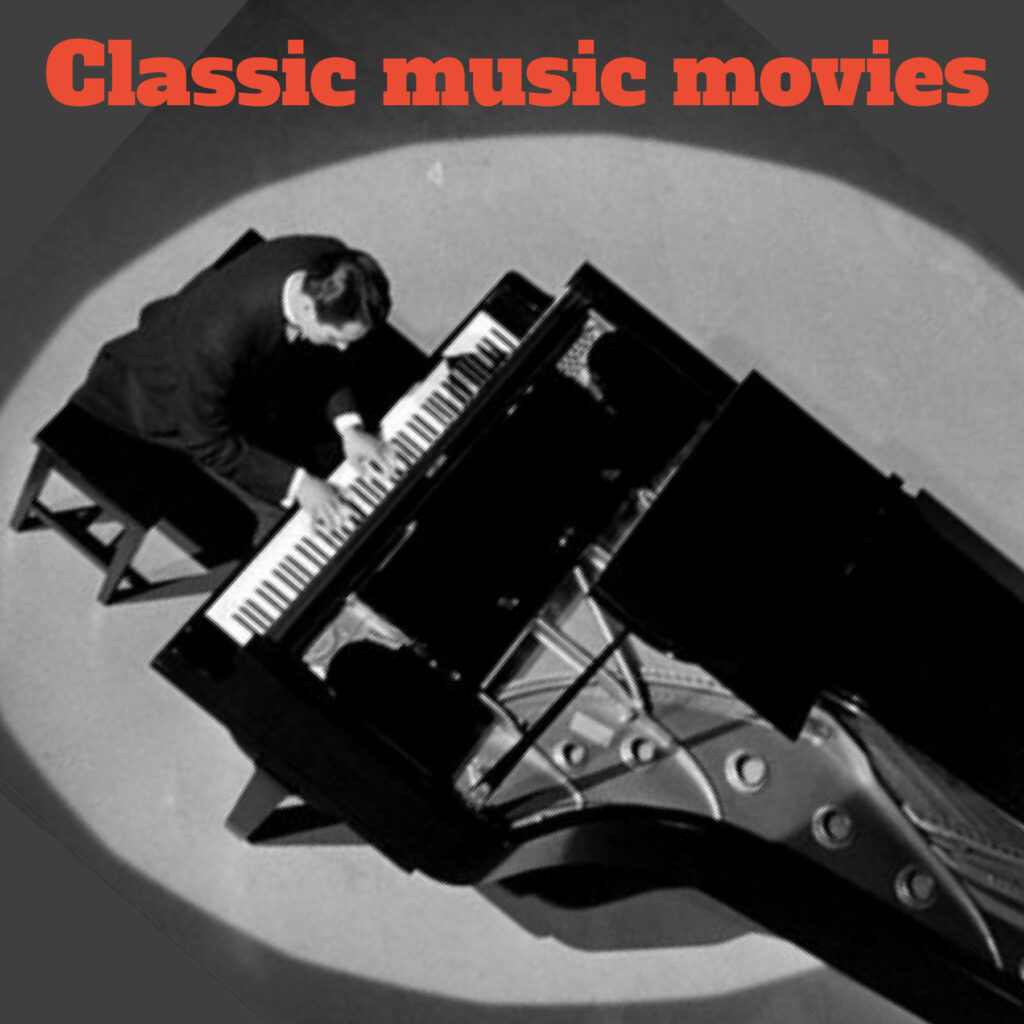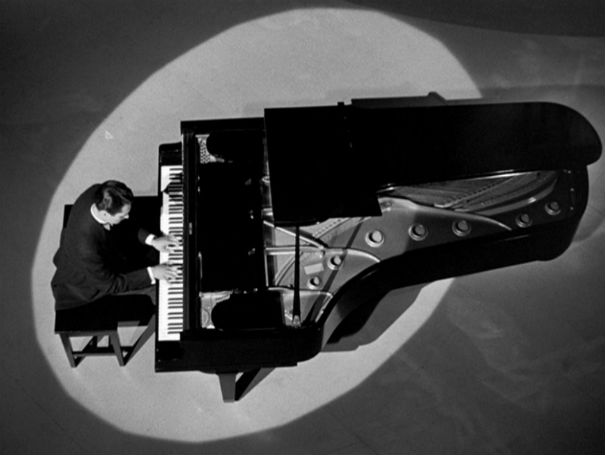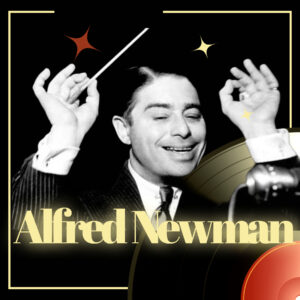
The following list of movies includes some of the best old films about classical music ever made.
Humoresque (1946)
Directed by Jean Negulesco
With breathtaking performances from two of Hollywood’s finest, Joan Crawford and John Garfield, Humoresque is easily one of Warner Brothers’ most class forays into melodrama territory. The two leading actors in the film are at their best and complement each other perfectly, Crawford’s predatory vamp well-matched against Garfield’s driven music maker. In this clash of titanic egos, it isn’t initially apparent who will crack first, but once music from Bizet’s Carmen fills our ears we see at once who is intended to play the ill-fated Don José role, and it isn’t Garfield.
As great as Crawford and Garfield are, the real star of Humoresque is the music, which not only propels the narrative and adds texture and emotional depth to the drama, but also serves as the third character in the eternal triangle. Few films have used music so imaginatively or so effectively as this one for dramatic purposes (Frank Waxman’s score).
As might be expected in a prestigious Hollywood production, Humoresque offers not only two major actors, but also a first-rate support distribution. Oscar Levant is a treat as a friend of Garfield, clearing up the atmosphere to prevent Humoresque from being completely humorless. As Garfield’s compassionate mother, Ruth Nelson provides much of the film’s emotional stimulus, her character’s no nonsense decency making Crawford’s selfish man-eater appear all the more vile and pitiful.
Jean Negulesco’s direction is understated but effective, relying on the performances, the music and Ernest Haller’s moody cinematography to tell the story and gently build the drama to its operatic climax. The tense, tragic denouement shows Negulesco at his most inspired and compassionate. Smart inter-cutting between two locations skilfully resolves the fate of the two lovers, the tragedy of the moment heightened by the aural backdrop of music from Wagner’s Tristan and Isolde. Here we see Joan Crawford at her most devastating. Once her character’s tough exterior has been shattered and trodden into the ground, we see her as she really is, a woman desperately in need of love but incapable of giving it.
Rhapsody In Blue (1945)
Directed by Irving Rapper
Irving Rapper’s expansive biopic of George Gershwin is very enjoyable, despite being fictional, is a must for fans of both old movies and classical music. It does stay relatively true to the story of his rise as one of America’s most beloved composers. It also features several cameos by real-life friends/colleagues of Gershwin, like Al Jolson, Oscar Levant, Paul Whiteman, George White, Hazel Scott and Anne Brown.
Robert Alda (father of Alan), does a wonderful job playing the driven musician. If you look at pictures of Gershwin, you’ll notice they did a pretty great job with this casting looks-wise, as well. There are several shots of Gershwin playing the piano and it made us wonder if it were a piano double or Alda really was that good.

Regardless, the film, like many a musical biopic of the era, is chock full of song performances – some of Gershwin alone and others reenactments of his Broadway songs. Most of the Broadway numbers – save the one where a much too old Al Jolson sings Swanee – are sung by Joan Leslie playing the fictional Julie Adams. Leslie was in a handful of films during her career – including a small role in 1941’s High Sierra – but this may well be her crowning achievement.
Hazel Scott, playing herself, sings snippets from several Gershwin tunes, including “The Man I Love”,”Clap Your Hands”,”Fascinating Rhythm,” “Yankee Doodle Blues,” and “I Got Rhythm”.
Oscar Levant is a hoot playing himself as well. Caustic as ever, Levant keeps Alda’s Gershwin grounded throughout the film. His mourning for the loss of his friend at the end is truly heartbreaking. Especially when you realize he is playing himself, thus the emotions on his face are likely caused by remembering his actual grief.
Unfaithfully Yours (1948)
Directed by Preston Sturges
This Preston Sturges classic, one of the most sophisticated humorous films ever created, received negative reviews and performed poorly at the box office. Rex Harrison, who is at the height of his comedic career, plays the hero, a symphony director (a spoof of Sir Thomas Beecham).
The conductor fantasizes about how he will handle the situation in three different ways, depending on the style of the music on the program—Rossini’s “Overture to Semiramide,” the “Pilgrim’s Chorus” from Wagner’s “Tannhäuser,” and Tchaikovsky’s “Francesca da Rimini.” The conductor is convinced that his wife (Linda Darnell) has been unfaithful to him. He desperately tries to transport them after the show.
He desperately tries to get to them after the show. Since this film has so many memorable lines and scenes, writers and directors have been ripping them off for years. However, nobody has ever come close to capturing the wild-man devilry of the best Preston Sturges comedy. Along with Barbara Lawrence, Kurt Kreuger, Edgar Kennedy, Rudy Vallee, and Lionel Stander.
Chronicle of Anna Magdalena Bach (1968)
Directed by Daniele Huillet, Jean-Marie Straub
The Chronicle of Anna Magdalena Bach (1968) by Jean-Marie Straub and Danièle Huillet is notable for its quietness. Bach’s compositions rise with a ferocious intensity that makes you want to hold your breath. The film’s central paradox is that, like any outstanding musical performance, despite its seeming stillness, tension emits from it.
The opening scene of the movie begins with a close-up of a musician playing, then pans out to see the complete ensemble. It then cuts rapidly to a young woman’s profile before returning to the music. A woman who is singing at the court tells us in the voiceover that she and several members of her family are musicians.
The woman thus shown is Bach’s wife Anna Magdalena Bach (played by musician Christiane Lang), a person who is only well-known to those who have read extensively about Bach’s life. While the majority of the movie is devoted to the music and the environments in which it was first heard, Anna Magdalena’s voice directs us and gives the movie a distinctive, enigmatic feel. The Chronicle of Anna Magdalena Bach, in contrast to many of the filmmakers’ works, has been restored, and the restored version is showing at Quad Cinema in the West Village to commemorate the film’s 50th birthday.
The Chronicle’s narrative components are kept to a minimum, as is typical of Straub-Huillet (as the filmmaker duo is called). The black-and-white photography was taken in natural light while the camera was still. All the parts are played by professional musicians, most notably Bach himself, Gustav Leonhardt. Significantly, Leonhardt was a leader in the 1960s movement known as “authentic music performance,” which promoted the use of vintage instruments like the harpsichord rather than modern ones like the piano.
Night Song (1948)
Directed by John Cromwell
A critic once gave the film a stern evaluation – Bosley Crowther panned the film’s “incredibly mawkish plot” and added: “Our old friend, the young musician who has a great concerto chasing through his mind but can’t get it down on paper because-well, something’s eating on him, is back again…and, so far as this reviewer sees things, neither he nor his concerto are improved. As a matter of fact, for our money, they are both worn uncomfortably thin in comparison to previous incarnations, and neither is long for this world…[T]he music, the prize concerto-well, that is really the thing which puts Night Song in the spotlight as baldfaced and absolute sham. For this scrappy and meaningless jangle by Leith Stevens is good for nothing more than an excuse for filming the fiddles, the drums and the batteries of horns.”
It could be predictable for this kind of soul-crushing plot (at a nightclub, pianist Dan Evans (Dana Andrews) impresses socialite Cathy Mallory (Merle Oberon) with his unique compositions. Learning from Dan’s best friend, bandleader Chick Morgan (Hoagy Carmichael), that the proud and embittered Dan is blind, Cathy nevertheless tries to befriend him, only to be rebuffed. The single-minded Cathy then arranges with Chick to meet Dan, pretending to be blind and poor, then secretly arranges a composition contest hoping that Dan will win money for an operation.) But the mere appearance of the unparalleled musical giant Artur Rubinstein on the screen is worth it.
Composer Leith Stevens wrote his Concerto in C Minor especially for the film. Artur Rubinstein reportedly added the concerto to his concert repertoire months before the film’s release. For Rubinstein’s tour, Stevens lengthened the concerto by eight minutes. To enhance his performance, Andrews wore specially designed opaque contact lenses, which rendered him sightless, during his “blind” scenes.
Although producer Harriet Parsons took a crew, including RKO sound department head John Aalberg, Aalberg’s assistant, Steve Dunn, and sound engineer Earl Mounce, to New York to record the concerto at Carnegie Hall, NYT reported that because of difficulties in moving sound equipment in and out of the hall between concerts, the entire concerto scene was finally shot on a replica set in Los Angeles. Other scenes in the film were shot in San Francisco, Trancas Beach and Lake Arrowhead, CA, and in various locations in New York City. Modern sources note that the picture lost $1,040,000 at the box office. Andrews reprised his role in a 29 May 1950 Lux Radio Theatre broadcast, co-starring Joan Fontaine.



